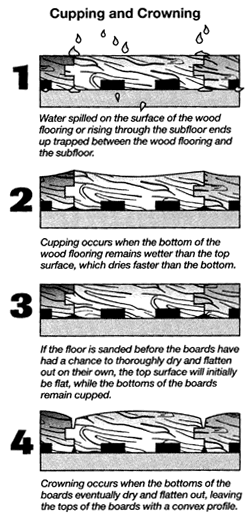In a comfortable home with slight humidity variations through the seasons, hardwood flooring responds by expanding and contracting. These changes may be noticeable. During warm, humid weather, hardwood expands. During dry weather, hardwood contracts. This seasonal movement is a normal characteristic of hardwood flooring, and it never stops, regardless of the age of the hardwood. One of the best ways to ensure that hardwood flooring will give the performance homeowners expect is to install humidity controls and ensure that they are functioning before the flooring is installed.
Working with humidity controls
A homeowner who chooses hardwood flooring is making an investment in a floor that will last 40 years or more, and he or she should protect that investment by installing humidity controls–a tool that helps the floor maintain a beautiful, trouble-free appearance.
Cracks and separations between boards
Nearly every floor endures some separation between boards. In winter, when homes are heated and the air is dry, wood flooring gives up some of its moisture and therefore shrinks. When that happens, thin cracks appear between. This is normal, and homeowners should be forewarned of this. It is acceptable, and customers should not be calling the installers at the first sign of cracks. Once the indoor heat goes off in the spring, and the indoor environment regains moisture, most of these cracks will close up.
Cracks in winter–in the drier months–may easily develop to the thickness of a dime (1/32 inch) for solid 2 1/4-inch wide strip oak floors. Floors with light stained hardwoods and naturally light hardwoods like maple tend to show cracks more than darker, wood-tone finished floors.
The cure for cracks? Homeowners should add moisture to the air during dry periods. It’s their choice-live with the cracks and wait until spring, or else add humidity by opening the dishwasher after a rinse cycle, switching off the bathroom fan or hanging laundry to dry in the basement near the furnace. Better yet, install a humidifier in the furnace, or an exterior air vent for the furnace burner.
If cracks are a concern, laminated flooring moves less and shows fewer gaps.
“Cupping and crowning” are common complaints that develop with high humidity. Both problems occur across the width of the flooring material.

Cupping is when the edges of a board are high and its center is lower. It can occur after water spills onto the floor and is absorbed by the wood, but high humidity is more often the cause. If the wood expands significantly, compression set can result as the boards are crushed together, deforming the boards at the edges.
Cupping is caused by a moisture imbalance through the thickness of the wood: The wood is wetter on the bottom of the board than on the top. The moisture imbalance can be proven by taking moisture meter readings at different pin depths.
The first step in repairing a cupped floor is to identify and eliminate the moisture source. In the kitchen, it may be a leak from the dishwasher or icemaker. From outdoors, it might be the terrain of the lot, with rain and runoff not moving away from the house and foundation. Indoors, the humidity may need to be controlled, or a plumbing leak may be causing excess moisture in the basement, which migrates up into the subfloor and from there into the hardwood flooring.
Once the source of the moisture is controlled, cupping can usually be cured. The floor may improve on its own as it dries out over time. Other times, fans may be needed to speed the drying process. Once the moisture content has stabilized, the floor can be reassessed. Choices may be to do nothing at all, to recoat the floor or to sand and refinish the floor. However, it should not be sanded until moisture-meter readings indicate the floor is thoroughly dried.
Crowning is the opposite of cupping: The center of a board is higher than the edges. Moisture imbalance is sometimes the cause of crowning if excessive moisture is introduced on the top of the floor, perhaps from water used in maintenance or plumbing leaks from an overhead sprinkler system. However, a common cause is that the floor was previously cupped, but was sanded at the wrong time-before the moisture content returned to normal and the board flattened on its own.
It should be noted that some slight cupping and crowning may occur naturally, and should be tolerated: The bark side of lumber shrinks and swells more than the side closest to the center of the tree. Largely seasonal in occurrence, it’s common in wider planks. Its appearance can be minimized by using a beveled-edge flooring product with a satin finish, rather than square-edge flooring with a high gloss finish.
Buckled floors
The “buckling” of hardwood flooring-when the flooring literary pulls away from the subfloor, lifting up to several inches in one or more places-is one of the most extreme reactions to moisture that can occur. Fortunately, it is not a common occurrence.
Buckling happens most often after a floor is flooded for a time, but there are numerous other causes. On nailed floors, insufficient nailing, incorrect nails or incorrect subfloor construction are possibilities. On glue-down floors, the causes range from the use of incorrect or insufficient mastic to an inadequate mastic transfer, a subfloor separation or a subfloor contamination.
In flooded hardwood strip flooring, the swelling stress is theoretically high enough to push out walls. However, before that can happen the nails or the glue holding the flooring to the subfloor wil1 usually give way, so that the floor bulges upward.
If buckling floors are caught early, spot repair and replacement may be possible. Once the standing water is removed, several boards may be taken up from the floor so that air can be circulated across and below the floor more effectively. Once the floor has dried to a more stable moisture level, repairs can usually be made.
